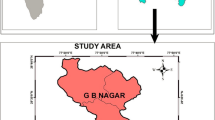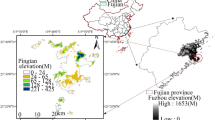Abstract
Urbanization is increasingly becoming a widespread phenomenon at all scales of development around the globe. Be it developing or developed nations, all are witnessing urbanization at very high pace. In order to study its impacts, various methodologies and techniques are being implemented to measure growth of urban extents over spatial and temporal domains. But urbanization being a very dynamic phenomenon has been facing ambiguities regarding methods to study its dynamism. This paper aims at quantifying urban expansion in Delhi, the capital city of India. The process has been studied using urban land cover pattern derived from Landsat TM/ETM satellite data for two decades (1998–2011). These maps show that built-up increased by 417 ha in first time period (1998–2003) and 6,633 ha during next period (2003–2011) of study. For quantification of metrics for urban expansion, the Urban Landscape Analysis Tool (ULAT) was employed. Land cover mapping was done with accuracy of 92.67 %, 93.3 % and 96 % respectively for years 1998, 2003 and 2011. Three major land covers classes mapped are; (i) built-up, (ii) water and (iii) other or non-built-up. The maps were then utilized to extract degree of urbanization based on spatial density of built-up area consisting of seven classes, (i) Urban built-up, (ii) Suburban built-up,(iii) Rural built-up, (iv) Urbanized open land, (v) Captured open land, (vi) Rural open land and (vii) Water. These classes were demarcated based on the urbanness of cells. Similarly urban footprint maps were generated. The two time maps were compared to qualitatively and quantitatively capture the dynamics of urban expansion in the city. Along with urbanized area and urban footprint maps, the new development areas during the study time periods were also identified. The new development areas consisted of three major categories of developments, (i) infill, (ii) extension and (iii) leapfrog.







Similar content being viewed by others
References
Azocar, G., Romero, H., Sanhueza, R., Vega, C., Aguayo, M., & Munoz, M. D. (2007). Urbanization patterns and their impacts on social restructuring of urban space in Chilean mid-cities: the case of Los Angeles, Central Chile. Land Use Policy, 24, 199–211.
Bhatta B, Saraswati S and Bandopadhyay D. (2010). Urban sprawl measurement from remote sensing data. Applied Geography, 30(1), 96–111.
Blair R. (2004). The effects of urban sprawl on birds at multiple levels of biological organization. Ecology and Society. University of Minnesota.
Brockerhoff, M. P. (2000). An urbanizing world. In M. M. Kent (Ed.), Population bulletin. Washington, DC: Population Reference Bureau.
Carlson TN. (2004). Analysis and prediction of surface runoff in an urbanizing watershed using satellite imagery. Journal of the American Water Resources Association 1087–1098.
Census of India. (2011). [Online] Available: http://censusindia.gov.in/2011-common/censusdataonline.html [Accessed 9-01-2012].
Cohen, B. (2006). Urbanization in developing countries: current trends, future projections, and key challenges for sustainability. Technology in Society, 28, 63–80.
Cralson, T. (2003). Application of remote sensing to urban problems. Remote Sensing of Environment, 86, 273–274.
Delhi Master Plan. (2021). [Online]. Available: http://delhi-masterplan.com/master-plan-2001.php [Accessed 14-6-2011].
Diwakar, A., & Qureshi, M. H. (1992). Demographic processes of urbanization in Delhi (Abstract only). Population Geography, 14, 27–36.
Dutta B K and Bandopadhyay S. (2011). Management of Delhi’s Urban Growth and Shrinkage. In: Schrenk M, Popovich, VV and Zeile P ed. REAL CORP 2011: Change For Stability - Lifecycles of Cities and Regions, 18–20, 581–590.
Fan, F., Wang, Y., & Wang, Z. (2008). Temporal and spatial change detecting (1998–2003) and predicting of land use and land cover in Core corridor of Pearl River Delta (China) by using TM and ETM+ images. Environmental Monitoring and Assessment, 137, 127–147.
Galster, G., Hanson, R., Ratcliffe, M. R., Wolman, H., Coleman, S., & Freihage, J. (2001). Wrestling sprawl to ground: defining and measuring an elusive concept. Housing Policy Debate, 12, 681–717.
Ghosh, P. (2007). Urbanization – A potential threat to the fragile Himalayan environment. Current Science, 93(2), 126–127.
Hasse, J. E., & Lathrop, R. G. (2003). Land resource impact indicators of urban sprawl. Applied Geography, 23, 159–175.
Jain M, Taubenböck H and Namperumal S. (2011). Seamless Urbanization and Knotted City Growth: Delhi Metropolitan Region. In: Schrenk M, Popovich VV, Zeile P, ed. Real CORP 2011: Change For Stability - Lifecycles of Cities and Regions, 18–20 853–862.
Joshi, P. K., Bairawa, B. M., Sharma, R., & Sinha, V. S. P. (2011). Assessing urbanization patterns over India using temporal DMSP–OLS night-time satellite data. Current Science, 100, 1479–1482.
Li, X., & Yeh, A. G. (2004). Analyzing spatial restructuring of land use patterns in a fast growing region using remote sensing and GIS. Landscape and Urban Planning, 69, 335–354.
Mallick J, Rahman A, Hoa PV and Joshi PK. (2009). Assessment of Night-Time Urban Surface Temperature -- Land Use/Cover Relationship for Thermal Urban Environment Studies Using Optical and Thermal Satellite Data In: Spatial Data Serving People: Land Governance and the Environment-Building the Capacity, 19–22 October 2009 Vietnam.
Mas, J. F. (1999). Monitoring land-cover changes: a comparison of change detection techniques. International Journal of Remote Sensing, 20, 139–152.
Mishra, O. P. (2011). Policing Delhi. New Delhi: Oxford University Press.
Nilsson, C., Pizzuto, J. E., Moglen, G. E., Palmer, M. A., Stanley, E. H., Bockstael, N. E., et al. (2003). Ecological forecasting and the urbanization of stream ecosystems: challenges for economists, hydrologists, geomorphologists, and ecologists. Ecosystems, 6, 659–674.
Owen, T. W., Carlson, T. N., & Gillies, R. R. (1998). An assessment of satellite remotely-sensed land cover parameters in quantitatively describing the climatic effect of urbanization. International Journal of Remote Sensing, 19, 1663–1681.
Parent J, Urban Landscape Analysis Tool [Online]. Available: http://clear.unconn.edu/tools/download.asp [Accessed 15-6-2011].
Parent J, Civco D and Angel S. (2008). Urban growth analysis: Calculating metrics to quantify urban sprawl [Online]. University of Connecticut. Available: http://clear.unconn.edu/publications/research/presentation/parent_esri2008.ppt [Accessed 29-7-2011].
Pijanowski, B. C., Alexandridis, K. T., & Muller, D. (2006). Modelling urbanization patterns in two diverse regions of the world. Journal of Land Use Science, 1(2–4), 83–108.
Savard, J. P. L., Clergeau, P., & Mennechez, G. (2000). Biodiversity concepts and urban ecosystems. Landscape and Urban Planning, 48, 131–142.
Su, W., Gu, C., Yang, G., Chen, S., & Zhen, F. (2010). Measuring the impact of urban sprawl on natural landscape pattern of the Western Taihu Lake watershed, China. Landscape and Urban Planning, 95, 61–67.
Taubenbock, H., Wegmann, M., Roth, A., Mehl, H., & Dech, S. (2009). Urbanization in India – Spatiotemporal analysis using remote sensing data. Computers, Environment and Urban Systems, 33, 179–188.
Taubenbock, H., Esch, T., Felbier, A., Weisner, M., Roth, A., & Dech, S. (2012). Monitoring urbanization in mega cities from space. Remote Sensing of Urban Environments, 117, 162–176.
Thapa, R. B., & Murayama, Y. (2009). Examining spatiotemporal urbanization patterns in Kathmandu Valley, Nepal: remote sensing and spatial metrics approaches. Remote Sensing, 1, 534–556.
Tian, G., Jiang, J., Yang, Z., & Zhang, Y. (2011). The urban growth, size distribution and spatio-temporal dynamic pattern of the Yangtze River Delta megalopolitan region, China. Ecological Modelling, 222(3), 865–878.
UN. (2010). World urbanization prospects: The 2009 revision. New York: United Nations Department of Economic and Social Affairs/Population Division.
Xiao, J., Shen, Y., Gec, J., Tateishi, R., Tang, C., Liang, Y., et al. (2006). Evaluating urban expansion and land use change in Shijiazhuang, China by using GIS and remote sensing. Landscape and Urban Planning, 75, 69–80.
Zha, Y., Gao, J., & Ni, S. (2003). Use of normalized difference built-up index in automatically mapping urban areas from TM imagery. International Journal of Remote Sensing, 24, 583–594.
Zhang, R., Lei, W., Tie, X., & Hess, P. (2004). Industrial emissions cause extreme urban ozone diurnal variability. Geophysics, 101, 6346–6350.
Acknowledgments
Authors are thankful to anonymous reviewers for suggestions. Authors also thank the Department of Science and Technology (DST), Ministry of Science and Technology (Government of India) for the funding and support.
Author information
Authors and Affiliations
Corresponding author
About this article
Cite this article
Sharma, R., Joshi, P.K. Monitoring Urban Landscape Dynamics Over Delhi (India) Using Remote Sensing (1998–2011) Inputs. J Indian Soc Remote Sens 41, 641–650 (2013). https://doi.org/10.1007/s12524-012-0248-x
Received:
Accepted:
Published:
Issue Date:
DOI: https://doi.org/10.1007/s12524-012-0248-x




